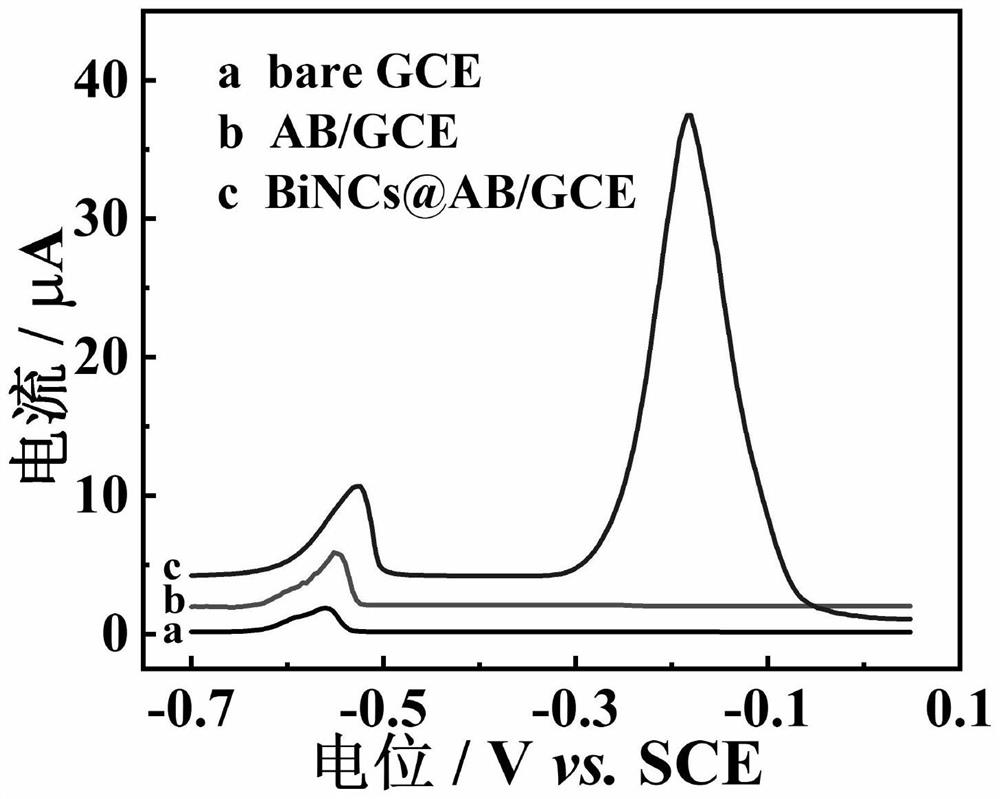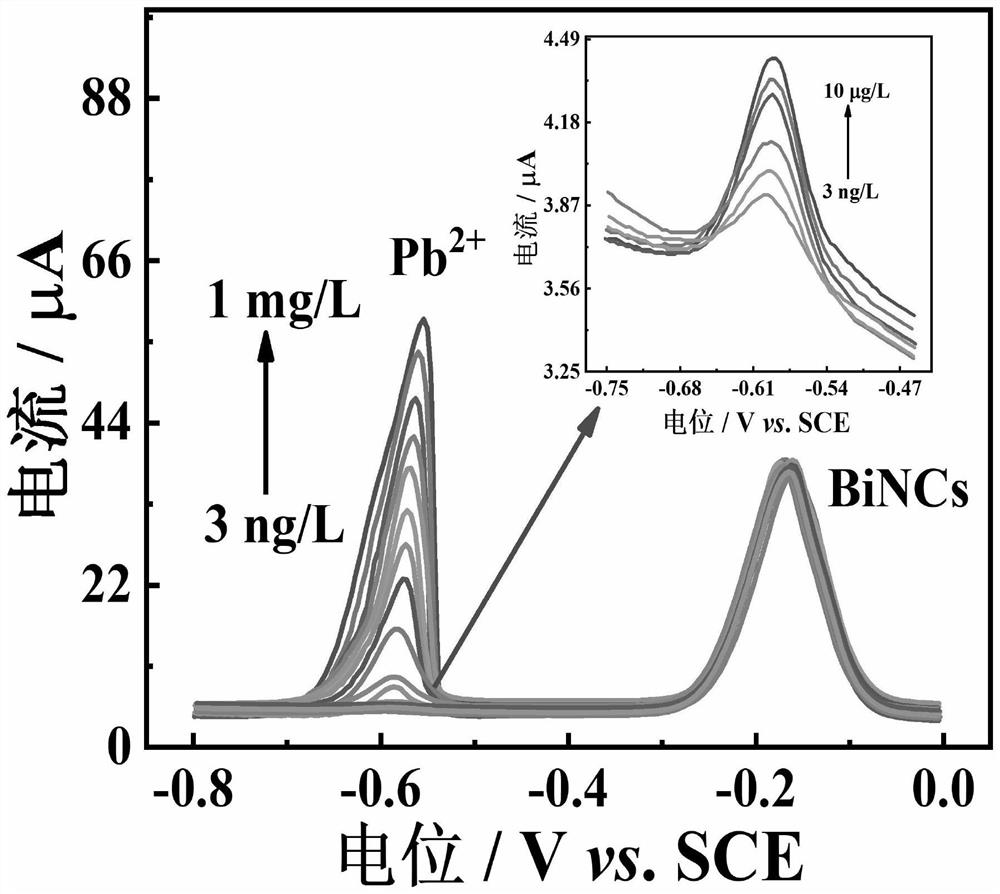Electrochemical sensor for detecting ratio of Pb<2+> with high sensitivity and application of electrochemical sensor
A sensor and electrochemical technology, applied in the field of ratio electrochemical sensors for high-sensitivity detection of Pb2+, can solve the problems of increasing operational complexity, affecting the electrochemical performance of electroactive substances, and achieving improved reproducibility, reliability, and strong selectivity. , the effect of easy operation
- Summary
- Abstract
- Description
- Claims
- Application Information
AI Technical Summary
Problems solved by technology
Method used
Image
Examples
Embodiment 1
[0043] A highly sensitive detection of Pb 2+ The electrode surface of the ratiometric electrochemical sensor is coated with bismuth nanoparticles@activated biochar (BiNCs@AB) composite.
[0044] The preparation method of BiNCs@AB composite material includes the following steps:
[0045] 1) Wash 100 g of litsea cubeba fruit with water to remove impurities, dry it (at 80° C. for 12 hours), and grind it into powder. Next, soak the ground magnolia fruit powder in 200 g of KOH solution with a concentration of 0.1 mol / L for 1 day to activate. After the activation is completed, the activated Magnolia magnanimum fruit powder is placed in a tube furnace, and the N 2 Under the atmosphere, the temperature was raised to 800°C at a heating rate of 5°C / min, and carbonized for 2h. The carbonized product was neutralized with dilute hydrochloric acid with a concentration of 0.1 mol / L, and finally AC was obtained by centrifugal drying.
[0046] 2) 0.4g AC was dissolved in 100mL ethanol to o...
Embodiment 2
[0050] Detection of Pb 2+ concentration
[0051] Different concentrations (1000μg / L, 900μg / L, 800μg / L, 700μg / L, 600μg / L, 500μg / L, 400μg / L, 300μg / L, 200μg / L, 70μg / L, 50μg / L, 10μg / L L, 9μg / L, 7μg / L, 5μg / L, 0.9μg / L, 0.003μg / L) Pb 2+ The solution was added into the 0.1M acetate buffer solution with a pH of 5.0, the electrochemical sensor prepared in Example 1 was connected to the test circuit, and the Pb 2+ Concentrations were measured as Pb 2+ Concentration is the abscissa (unit is μg / L), with I Pb 2+ / I BiNCs As the ordinate (in μA), the standard curve I is established Pb 2+ / I BiNCs (μA)=0.0091+0.0015c(μg / L)(R 2 = 0.9917).
[0052] Such as Figure 4 Shown, the electrochemical sensor that embodiment 1 prepares is to Pb 2+ have a good linear relationship (R 2 =0.9917), and has a wide linear range (0.003μg·L -1 -1000μg·L -1 ) and high sensitivity and low detection limit (1.0ng / L), fully demonstrate that the sensing electrode can successfully detect Pb in unknown con...
Embodiment 3
[0054] Using the bare glassy carbon electrode, the glassy carbon electrode modified by BiNCs, the glassy carbon electrode modified by AB (i.e. bare GCE, BiNCs / GCE and AB / GCE) and the sensor prepared in Example 1, the Pb 2+ For detection, test different modified electrodes for Pb 2+ The detection responsivity, see the results figure 2 .
[0055] Depend on figure 2 It can be seen that the sensor prepared in Example 1 (i.e. BiNCs@AB / GCE) can detect extremely low Pb concentrations relative to BiNCs / GCE, AB / GCE and bare GCE 2+ The detection sensitivity is better than that of BiNCs and AB-modified glassy carbon electrodes.
PUM
| Property | Measurement | Unit |
|---|---|---|
| Concentration | aaaaa | aaaaa |
Abstract
Description
Claims
Application Information
 Login to View More
Login to View More - R&D
- Intellectual Property
- Life Sciences
- Materials
- Tech Scout
- Unparalleled Data Quality
- Higher Quality Content
- 60% Fewer Hallucinations
Browse by: Latest US Patents, China's latest patents, Technical Efficacy Thesaurus, Application Domain, Technology Topic, Popular Technical Reports.
© 2025 PatSnap. All rights reserved.Legal|Privacy policy|Modern Slavery Act Transparency Statement|Sitemap|About US| Contact US: help@patsnap.com



